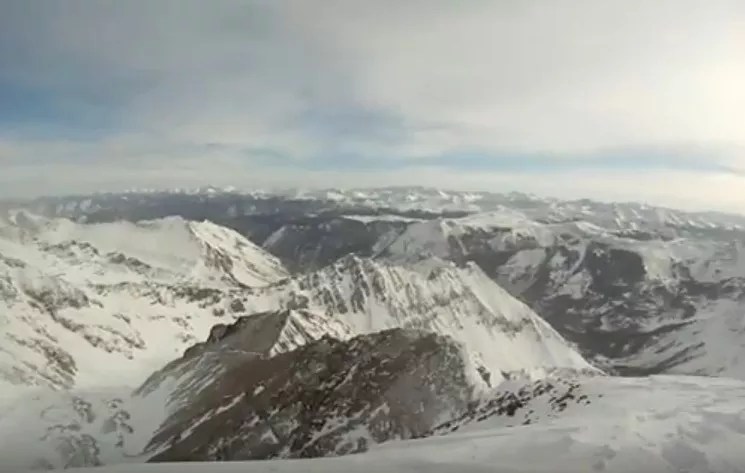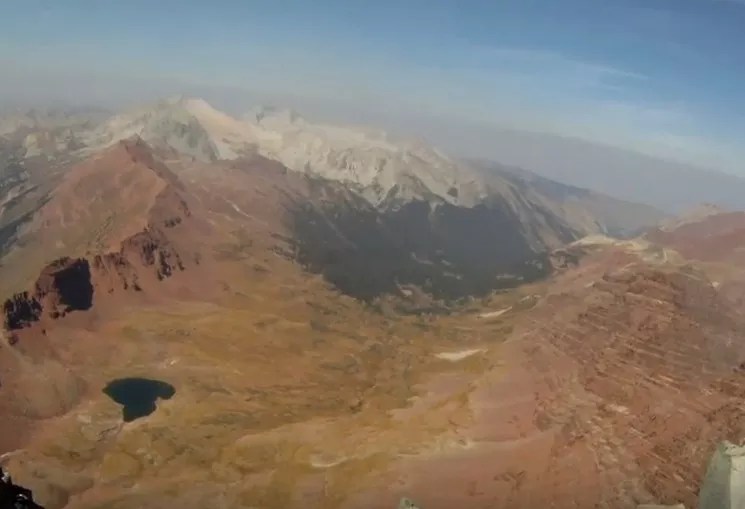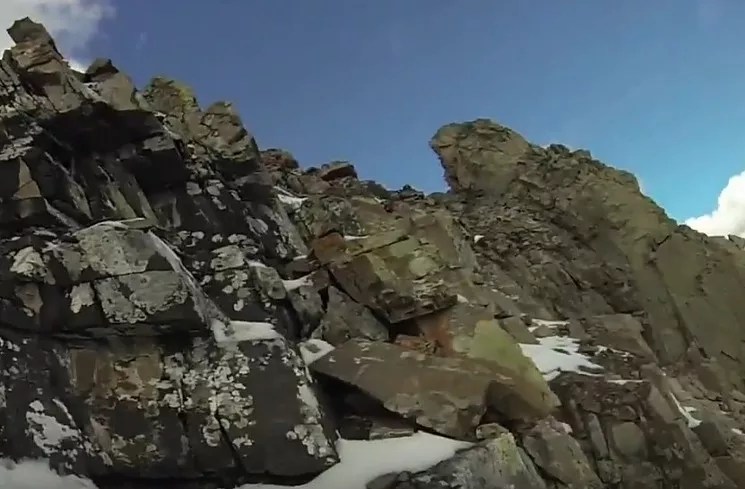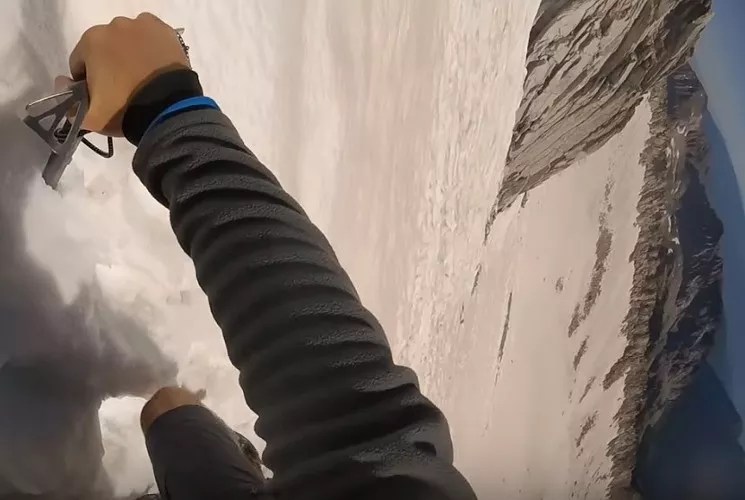

Audio By Carbonatix
Colorado fourteeners are gorgeous, but they can also be deadly. Since caution is key when attempting to summit these magnificent peaks, we reached out to Lloyd Athearn, executive director of the Colorado Fourteeners Initiative, who offers the following ten tips for challenging Colorado fourteeners safely.
Number 1: Be ready for thin air
“All of these peaks are high-altitude,” Athearn says. “So everyone, and especially someone coming from a lower altitude, needs to be prepared for the lack of oxygen and the physiological problems that can come from being at high altitude. They need to make sure they’re physically in shape to handle the many hours they’ll be on the mountain.”
If they’re not, climbers should improve their condition and stamina by tackling less demanding terrain and work their way up to the point where they can take on a fourteener without worrying about faltering halfway through.

The Elk Mountains’ Castle Peak.
YouTube file photo
Number 2: Watch the skies
Athearn points out that “weather and lightning-related hazards occur regularly. Most people are out on the fourteeners in July and August, which coincides with the monsoon season, when there are almost daily intense thunderstorms. So people should get an early start to maximize the likelihood that they’ll be climbing in good weather and won’t be subject to the general afternoon thunderstorms.”
Number 3: Even an early start may not be early enough
The caveat to tip two above is that “the weather gods don’t have watches,” Athearn concedes. “So lightning and thunder can come at any time of the day. A lot of people buy into the notion that, ‘If I’m off the mountain by noon, I’ll be okay.’ But there can be lightning at 9 a.m., 10 a.m. Most storms come in the afternoon, but there’s no guarantee they won’t pop up. So when I’m on the mountains, I have my head on a swivel, looking to see if clouds are building or getting really dark. If they are, it’s time to go down, no matter what time it says on my watch.”

The view from Maroon Peak.
YouTube file photo
Number 4: Snow can arrive ahead of schedule
Even if the weather is warm in town, it can be cold enough to produce snow at the top of a fourteener, even at this time of year. That’s why checking snow conditions is a must. The online resources for doing so include the National Weather Service’s Colorado fourteeners page.
“With snow conditions, you need to approach it with the mindset of, ‘The mountain’s going to be there tomorrow,'” Athearn points out. “If anything doesn’t seem right, back off.”
Number 5: What looks firm may not be
“There are a lot of different hazards that can be faced on fourteener routes,” Athearn allows. “Some of them have very easy trails and pose little in the way of what we would call objective hazards – things like rock falls. But there are other scrambles that are quite committing, where people are subject to handholds breaking loose, rocks falling from above and, depending on the season, avalanche cornices breaking off and falling on people.”
Testing handholds in advance rather than simply assuming they’ll hold firm is a good idea, as is visually examining the route to identify the places where rock falls are most likely to occur.

Pyramid Peak.
YouTube file photo
Number 6: Don’t believe everything you read online
Anyone with even a rudimentary command of Google can pull up plenty of online forums where folks can share their experiences climbing fourteeners – and Athearn warns against simply assuming that all of them are on the mark.
“I don’t want to put the finger of blame on any news source or discussion forums,” he insists. “But sometimes people can say, ‘These are all okay. Any reasonably fit person can do these mountains. They’re not a big deal.’ But sometimes, for whatever reason, they downplay the inherent hazards that are out there.”
With that in mind, Athearn suggests preparing seriously for any fourteener – even the ones most web commenters treat like cakewalks. If they turn out to be a snap, no big deal. And if they’re tougher than advertised, you won’t be caught by surprise.
Number 7: Just because one person can do it doesn’t mean you can
“Alex Honnold just free-summited the nose of El Capitan,” Athearn says. “It’s a climb no one had ever done without a rope, without protection. A few decades ago, that was considered to be a difficult aid climb. But just because he had the technical ability and mental control to do an extremely dangerous route without using a rope or a harness doesn’t mean that mere mortals should do it.”

Snowmass Mountain.
YouTube file photo
Number 8: Know how you’re getting up – and getting down
“When you go up a mountain, unless you’re consciously stopping and turning around and saying, ‘This is what the view looks like when you’re going down,’ you might come down a route you didn’t come up,” Athearn maintains. “You might think it’s the same, but if you’re not clear about where you are, you could be dealing with loose rock on the way down that you didn’t see on the way up. And that can be a pretty lethal combination.”
Number 9: Don’t take anything for granted
“I remember there was what turned out to be a fatality on Snowmass mountain that really kind of hit me,” Athearn recalls. “The person seemed to be capable of the climb and was doing well. But as he was passing through a particular area, there was a massive rockfall that pinned him, and he died of trauma from a part of the mountain that had been there for a long time but just gave way. Those are the types of objective hazards in mountaineering that can’t be mitigated against – like the handhold that other people have used, but if you pull on it in a slightly different direction, it pops out, you lose your balance, you fall and get hurt or killed. Those are the risks that you can never completely control in some of these mountain ranges – particularly the Elks and the San Juans, where you have the combination of more technical climbing routes and loose rock.”
Those who want to avoid such prospects should stay away from these fourteeners, period.
Number 10: Use experience to your advantage
“I’ve been climbing mountains for 35 years,” Athearn says, “and the longer I do it, the more cautious I get about assessing the risks and making sure that if I’m pushing my limits, it’s on a good day and I’m feeling like I’m really in charge of the route I’m doing and I have all the information I need about where it goes. I think with the passage of time, you become more aware of your limits and more aware of the fact that you don’t control everything about the environment you’re in.”
Click to access the Colorado Fourteeners Initiative’s rankings of fourteeners by difficulty and routes by difficulty.